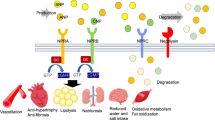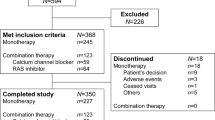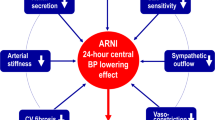Abstract
Although current hypertension management guidelines recommend increasingly stringent blood pressure targets, these targets are seldom achieved in clinical practice. Even in patients with mild-to-moderate hypertension, monotherapy is only effective in approximately 50–70% of patients, and thus there is a clear need for combination therapy if stringent blood pressure targets are to be achieved. Drugs used in combination therapy should satisfy a number of prerequisites, including complementary mechanisms of action, enhanced efficacy in combination, and maintained (or improved) tolerability. Evidence is accumulating that combination therapy with an AT1-receptor blocker and a diuretic represents a rational and effective treatment option. In clinical trials, the combination of candesartan cilexetil, 16 mg, and hydrochlorothiazide, 12.5 mg, has been shown to be more effective in lowering blood pressure than either agent alone. Furthermore, this combination has been shown to reduce blood pressure to a greater extent, and control blood pressure in a higher proportion of patients, than the combination of losartan, 50 mg, and hydrochlorothiazide, 12.5 mg, both when used instead of or in addition to previous antihypertensive therapy. The placebo-like tolerability of AT1-receptor blockers was maintained when these drugs were used in combination with hydrochlorothiazide. The combination of candesartan and a dihydropyridine calcium antagonist has also been shown to be more effective than either component alone. Furthermore, in the Candesartan and Lisinopril Microalbuminuria (CALM) Study, the combination of candesartan and lisinopril reduced blood pressure to a greater extent than either agent alone, and tended to have a greater effect on microalbuminuria.
This is a preview of subscription content, access via your institution
Access options
Subscribe to this journal
Receive 12 digital issues and online access to articles
$119.00 per year
only $9.92 per issue
Buy this article
- Purchase on Springer Link
- Instant access to full article PDF
Prices may be subject to local taxes which are calculated during checkout







Similar content being viewed by others
References
Guidelines Subcommittee. 1999 World Health Organization – International Society of Hypertension. Guidelines for the management of hypertension J Hypertens 1999 17: 151–183
Taylor Nelson Sofres Healthcare. CardioMonitor® Study© 1998
Mancia G, Grassi G . Rationale for the use of a fixed combination in the treatment of hypertension Eur Heart J 1999 1 (Suppl L): L14–L19
Sever PS . The heterogeneity of hypertension Eur Heart J 1999 1 (Suppl L): L10–L13
Materson BJ, Reda DJ, Cushman WC . Department of Veterans Affairs single-drug therapy of hypertension study. Revised figures and new data. Department of Veterans Affairs Cooperative Study Group on Antihypertensive Agents Am J Hypertens 1995 8: 189–192
Lacourcière Y, Asmar R . A comparison of the efficacy and duration of action of candesartan cilexetil and losartan as assessed by clinic and ambulatory blood pressure after a missed dose, in truly hypertensivepatients. A placebo-controlled, forced titration study Am J Hypertens 1999 12: 1181–1187
Meredith PA . Clinical comparative trials of angiotensin II type 1 (AT1)-receptor blockers Blood Press 2001 10 (Suppl 3): 11–17
Jones JK et al. Discontinuation of and changes in treatment after start of new courses of antihypertensive drugs: a study of a United Kingdom population Br Med J 1995 311: 293–295
Bloom BS . Continuation of initial antihypertensive medication after one year of therapy Clin Ther 1998 20: 671–681
Chaput AJ . Persistency with angiotensin receptor blockers (ARB) versus other antihypertensives (AHT) using the Saskatchewan database Can J Cardiol 2000 16 (Suppl F): 194F (abstract 390)
Hansson L et al. Effects of intensive blood-pressure lowering and low-dose aspirin inpatients with hypertension: principal results of the Hypertension Optimal Treatment (HOT) randomised trial Lancet 1998 351: 1755–1762
Oparil S . Newly emerging pharmacologic differences in angiotensin II receptor blockers Am J Hypertens 2000 13 (Pt 2): 18S–24S
Elmfeldt D, George M, Hübner R, Olofsson B . Candesartan cilexetil, a new generation angiotensin II antagonist, provides dose dependent antihypertensive effect J Hum Hypertens 1997 11 (Suppl 2): S49–S53
Belcher G et al. Candesartan cilexetil: safety and tolerability in healthy volunteers andpatients with hypertension J Hum Hypertens 1997 11 (Suppl 2): S85–S89
Jonkman JHG et al. Pharmacokinetic drug interaction studies with candesartan cilexetil J Hum Hypertens 1997 11 (Suppl 2): S31–S36
The MRC Working Party. Medical Research Council trial of treatment of hypertension in older adults: principal results Br Med J 1992 304: 405–412
Dahlöf B et al. Morbidity and mortality in the Swedish Trial in Old Patients with Hypertension (STOP-Hypertension) Lancet 1991 338: 1281–1285
Philipp T, Letzel H, Arens H-J . Dose-finding study of candesartan cilexetil plus hydrochlorothiazide inpatients with mild to moderate hypertension J Hum Hypertens 1997 11 (Suppl 2): S67–S68
Baumgart P . Efficacy and safety of candesartan cilexetil in combination with hydrochlorothiazide as measured using 24 hr ambulatory blood pressure measurement J Hypertens 2000 18 (Suppl 2): S47
Oparil S et al. Effects of candesartan cilexetil inpatients with severe systemic hypertension Am JCardiol 1999 84: 289–293
Oparil S, Michelson EL for the Candesartan Cilexetil Study Investigators. Long-term efficacy, safety, andtolerability of candesartan cilexetil added to hydrochlorothiazide inpatients with severe systemic hypertension Am J Hypertens 1999 12 (4 part 2): 120A
Hollenberg NK, Sever PS . The past, present and future of hypertension management: a potential role for AT1-receptor antagonists JRAAS 2000 1: 5–10
Öhman KP, Milon H, Valnes K . Efficacy and tolerability of a combination tablet of candesartan cilexetil and hydrochlorothiazide in insufficiently controlled primary hypertension – comparison with a combination of losartan and hydrochlorothiazide Blood Press 2000 9: 214–220
Koenig W on behalf of the Multicentre Study Group. Comparison of the efficacy and tolerability of combination tablets containing candesartan cilexetil and hydrochlorothiazide or losartan and hydrochlorothiazide inpatients with moderate to severe hypertension. Results of the CARLOS-Study Clin Drug Invest 2000 19: 239–246
Belcher G, Lunde H, Elmfeldt D, George M . The combination tablet of candesartan cilexetil 16 mg and hydrochlorothiazide 12.5 mg has a tolerability profile similar to that of placebo J Hypertens 2000 18 (Suppl 2): S94
Morgan T, MacInnis R, Bertram D, Anderson A . The effect of candesartan, felodipine or their combination on 24h ambulatory blood pressure Am J Hypertens 2001 14 (4, pt 2): 27A
Morgan T, MacInnis R, Bertram D, Anderson A . The effect of candesartan, felodipine or their combination on 24h blood pressure and microalbuminuria JHypertens 2001 19 (Suppl 2): S174
Farsang C et al. Antihypertensive effects and tolerability of candesartan cilexetil alone and in combination with amlodipine Clin Drug Invest 2001 2: 17–23
Mogensen CE et al. Randomised controlled trial of dual blockade of renin-angiotensin system inpatients with hypertension, microalbuminuria, and non-insulin dependent diabetes: the candesartan and lisinopril microalbuminuria (CALM) study Br Med J 2000 321: 1440–1444
Author information
Authors and Affiliations
Corresponding author
Rights and permissions
About this article
Cite this article
Trenkwalder, P. Combination therapy with AT1-receptor blockers. J Hum Hypertens 16 (Suppl 3), S17–S25 (2002). https://doi.org/10.1038/sj.jhh.1001435
Published:
Issue Date:
DOI: https://doi.org/10.1038/sj.jhh.1001435



